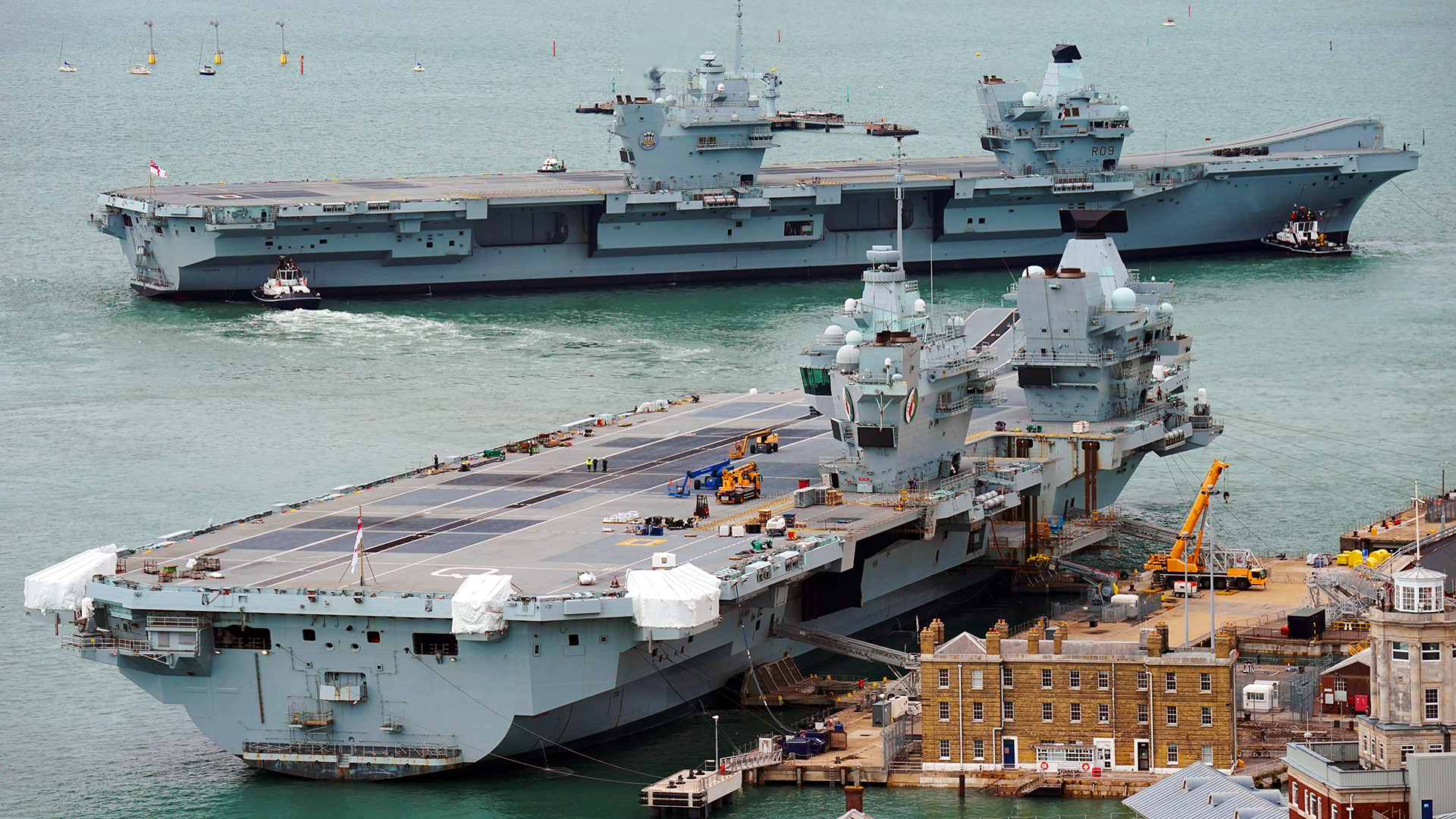The United Kingdom has outlined plans for its future carrier air wing, which should include drones and undisclosed long-range missiles that would be launched from its deck, alongside the F-35B stealth fighters that currently go aboard its two flattops. While there have been ongoing efforts to trial drones aboard the two Queen Elizabeth class aircraft carriers, the long-range weapons and the broader effort stressing the combination of “high and low” capabilities in the future carrier air wing are new developments.
What are described as “the first European hybrid air wings” are laid out in the latest Strategic Defense Review, published yesterday by the U.K. Ministry of Defense.
“The Royal Navy must continue to move towards a more powerful but cheaper and simpler fleet, developing a ‘high-low’ mix of equipment and weapons that exploits autonomy and digital integration,” the review states. “Carrier strike is already at the cutting edge of NATO capability, but much more rapid progress is needed in its evolution into ‘hybrid’ carrier air wings, whereby crewed combat aircraft (F-35B) are complemented by autonomous collaborative platforms in the air, and expendable, single-use drones. Plans for the hybrid carrier air wings should also include long-range precision missiles capable of being fired from the carrier deck.”
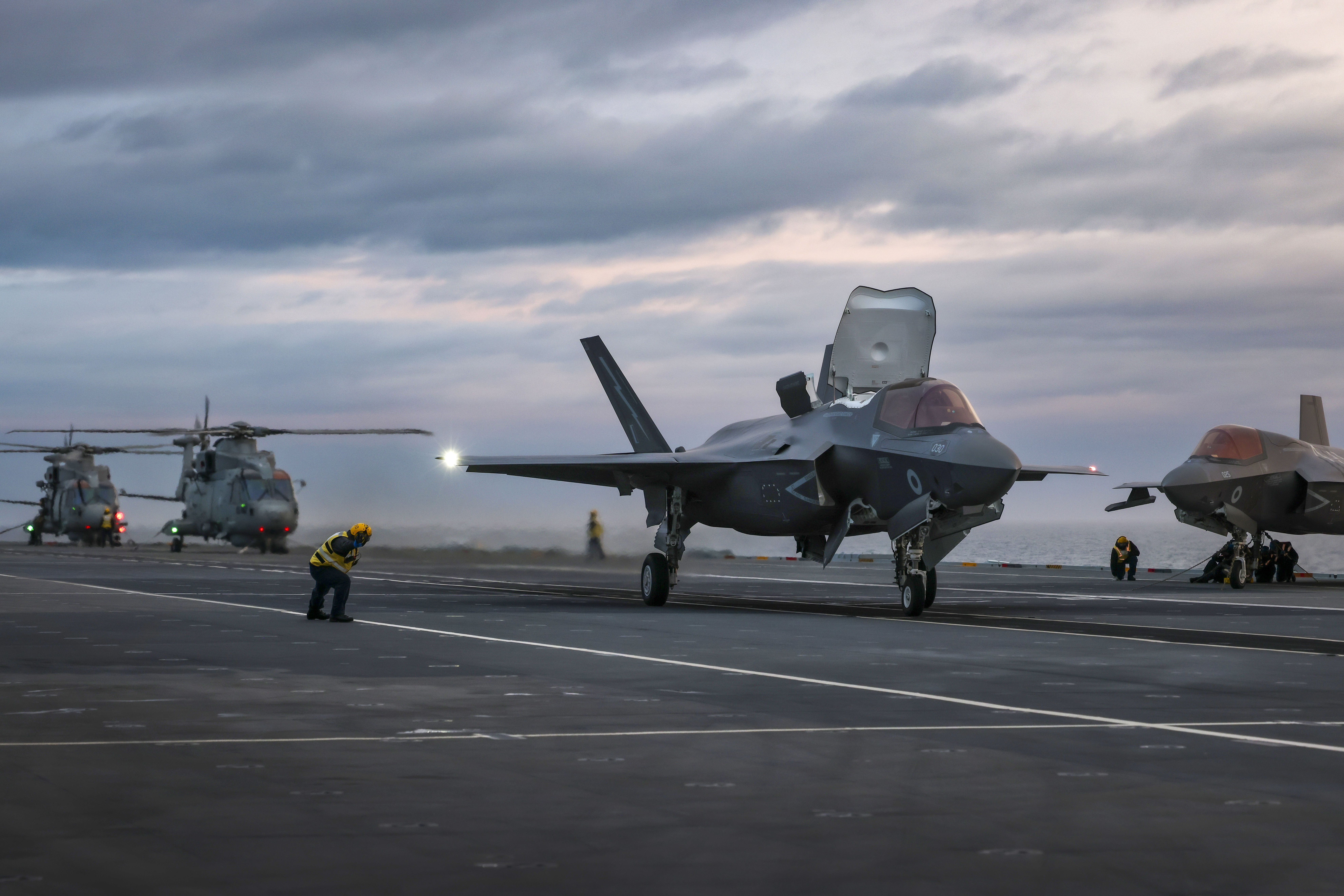
That the F-35B remains the cornerstone of the carrier air wing’s strike capability is no surprise. The Queen Elizabeth class carriers were tailored for operations involving the short takeoff and vertical landing (STOVL) jet, although there remain questions about exactly how many of these aircraft the United Kingdom will procure.
In the past, the U.K. government said it planned to buy 138 F-35Bs. So far, however, firm orders have only been placed for 48. Meanwhile, the previous Conservative government confirmed it was negotiating to buy another 27 for delivery by 2033.
Most analysts consider that many more than 48 F-35Bs would be required to meet the ambition of 24 jets available for the baseline Carrier Strike mission, across both ships. Considering training and other demands, a figure of 60-70 jets is generally thought to be reasonable. In the meantime, U.S. Marine Corps F-35Bs are being relied upon to make up the required aircraft numbers during carrier cruises.
The review concludes only that “More F-35s will be required over the next decade.” However, it doesn’t put any final number on the Joint Strike Fighter buy. Moreover, it suggests that the future Lightning force could comprise a mix of conventional takeoff and landing (CTOL) F-35As and F-35Bs. The F-35A, of course, is unable to operate from aircraft carriers, but such a mix could be adopted “according to military requirements to provide greater value for money.”
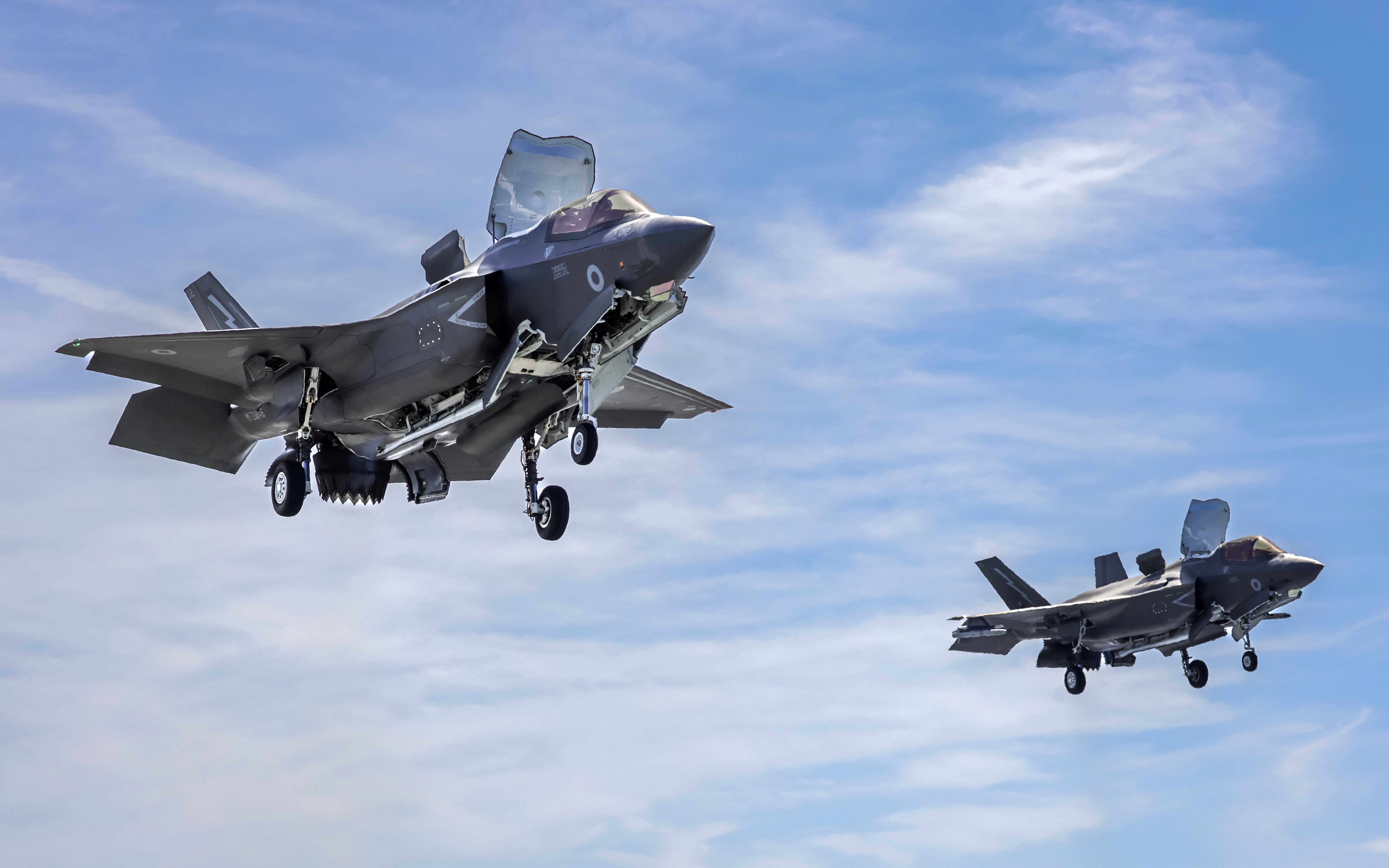
The F-35A is not currently operated by the United Kingdom. The F-35A is less expensive than the F-35B and, apart from STOVL, is more capable, boasting superior range and payload. The F-35A is also a 9G-capable jet, while the F-35B is cleared for 7.5G. Some commentators have taken the reference to a potential U.K. F-35A buy as evidence of plans to join the NATO nuclear sharing arrangement, under which these aircraft are provided with U.S.-owned B61-12 tactical nuclear bombs. However, the review doesn’t mention this possibility, or any plans to field tactical nuclear weapons.
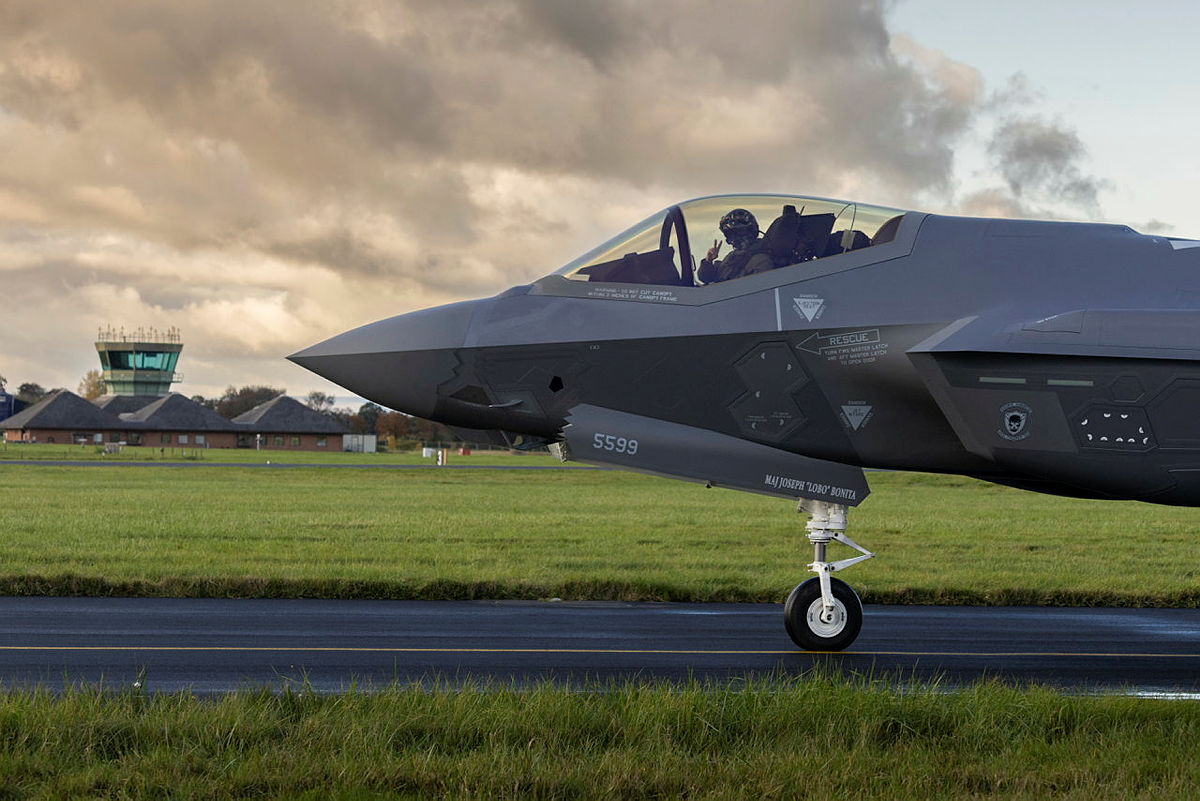
Should the United Kingdom choose to buy F-35As, it might even threaten the future of the Global Combat Air Program (GCAP), the future air combat initiative at the heart of which is the Tempest crewed stealth fighter. Regardless of its impact on that, it would leave the Royal Navy struggling to meet its Carrier Strike demands. With that in mind, it would likely have to rely much more heavily on drones and long-range weapons. In regard to these, the review outlines “autonomous collaborative platforms in the air [and] single-use drones” as part of the hybrid carrier air wing of the future.
The Royal Navy has, for some time now, been looking at ways to integrate drones into its future carrier air wing.
Back in 2023, the Royal Navy revealed details of its intention to fit its two carriers with assisted launch systems and recovery gear, enabling operations by a variety of fixed-wing uncrewed aircraft and, potentially, also conventional takeoff and landing crewed types.
“We are looking to move from STOVL to STOL, then to STOBAR [short takeoff but arrested recovery], and then to CATOBAR [catapult assisted takeoff but arrested recovery],” Col. Phil Kelly, the Royal Navy’s Head of Carrier Strike and Maritime Aviation, told the Combined Naval Event conference in 2023. “We are looking at a demonstrable progression that spreads out the financial cost and incrementally improves capability.”
Even before this, there had been indications that the service wanted to at least explore adding different drones to its future carrier air wing. The United Kingdom is not alone in this, with China and Turkey, most notably, also increasingly putting drones aboard big-deck amphibious warfare vessels and other non-conventional-takeoff-and-landing aircraft carriers.
The Royal Navy kicked off the project with tests of the General Atomics Mojave short takeoff and landing (STOL) drone aboard the carrier HMS Prince of Wales in late 2023, as you can read about here. The Mojave’s impressive STOL capabilities mean that no launch and recovery systems were required for these tests.
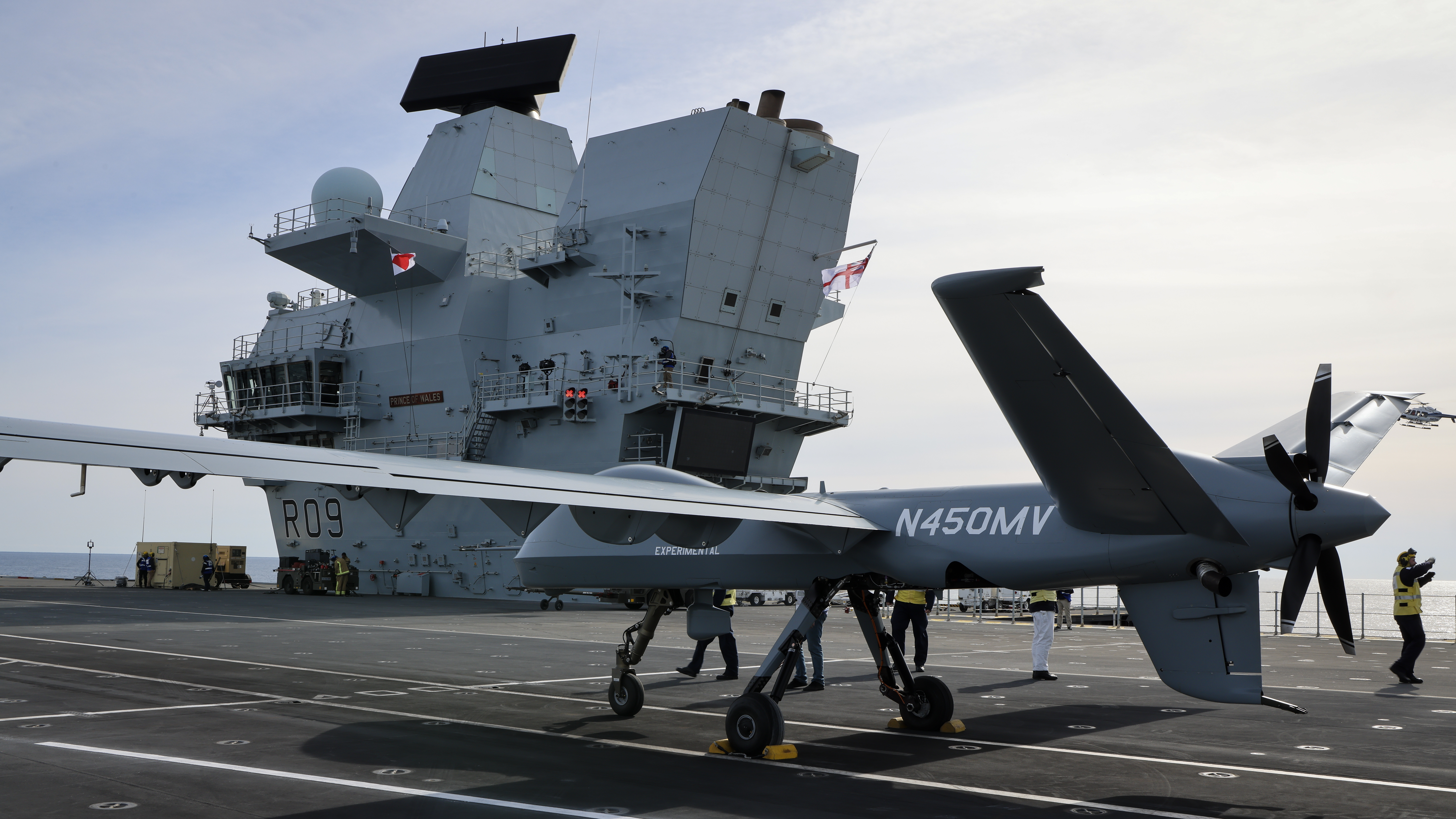
The ‘cat and trap’ plan for drone operations aboard U.K. carriers is known as Project Ark Royal (named after the Royal Navy’s last aircraft carrier that was capable of CATOBAR operations).
If realized, the project will see the Queen Elizabeth class carriers start to operate drones that can undertake a variety of missions and then increasingly heavier, complex, and higher performance ones. Later on, full CATOBAR capability could also add fixed-wing crewed aircraft, too.
After the Mojave trials, the next phase of Project Ark Royal aims to install some kind of recovery system on the Queen Elizabeth design, allowing operations by larger fixed-wing drones. Uncrewed aircraft in this category are an aspiration that the Royal Navy is already working toward under Project Vixen, which you can read more about here.
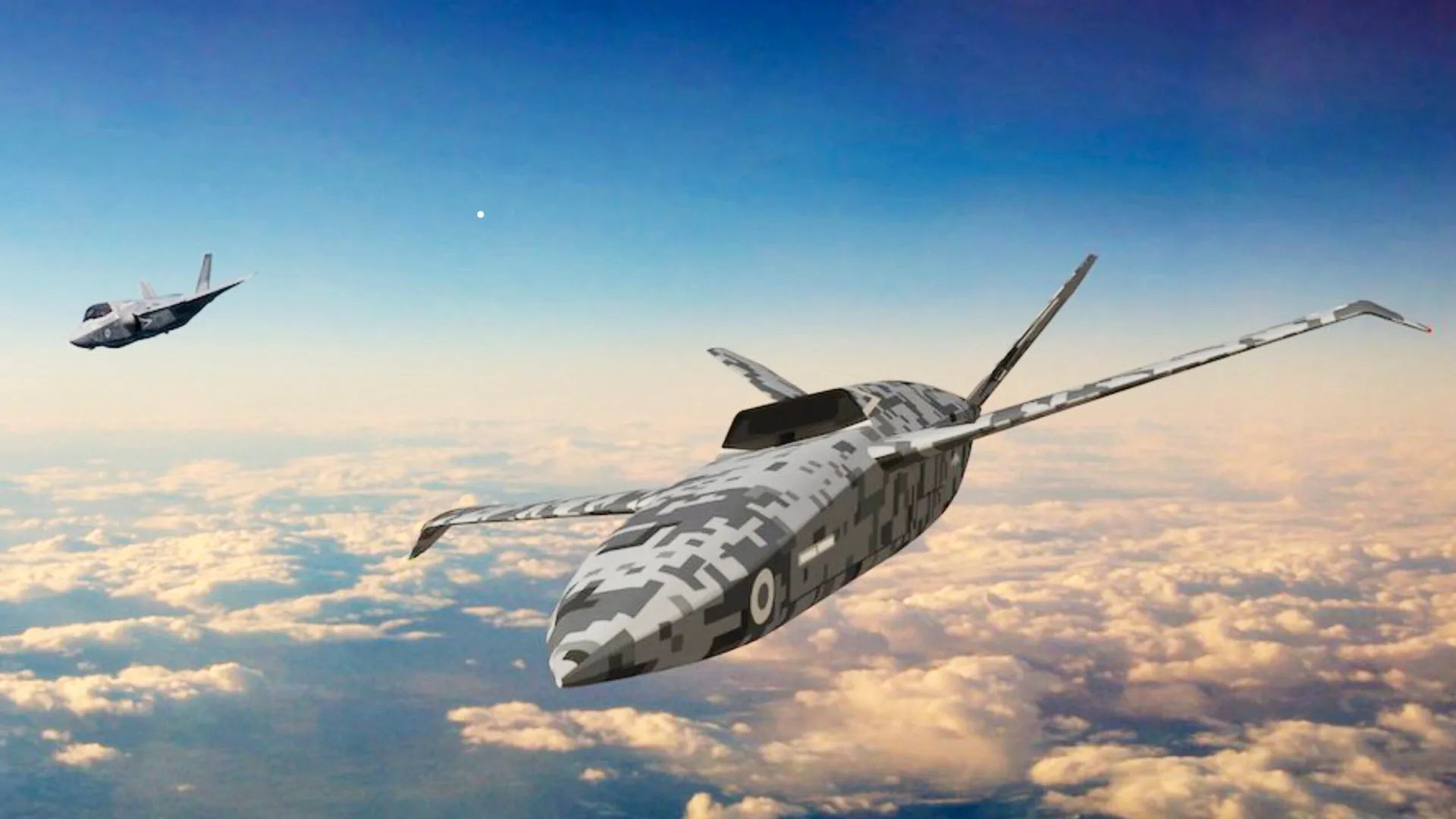
Finally, the Queen Elizabeth class design is planned to be reworked with catapult launch gear, allowing the warships “to operate the heaviest aircraft you can imagine,” in the words of Kelly. That would include larger, high-performance drones, but potentially also crewed fixed-wing aircraft, which would be a very significant development for the Queen Elizabeth class. As it stands, the carriers are unable to operate fixed-wing airborne early warning aircraft or airborne tankers, putting limits on their offensive operations. In the future, these functions could potentially be taken on by a catapult-launched fixed-wing aircraft, whether crewed or uncrewed.
A replacement for the carrier air wing’s airborne early warning capability will become especially urgent, with plans to retire the current Merlin Crowsnest helicopter, which currently fulfills this role, at the end of 2029.

According to previous reports, the Royal Navy has already been looking at different catapult launch solutions, including the U.S.-developed Electromagnetic Aircraft Launch System (EMALS), the introduction of which has been far from trouble-free, as well as the U.K.-developed Electro Magnetic Kinetic Induction Technology demonstrator. Finding room for complex launch and recovery systems, as well as fielding the manpower to maintain and operate them, will be a challenge no matter how much extra space the vessels have to accommodate them.

As we have explored in the past, there are many more technological hurdles for the Royal Navy to overcome, beyond the launch and recovery systems. It will also need to develop control stations, datalinks, unique procedures, and much more to ensure the drones can be safely and effectively integrated within the carrier air group, for example. Even working out the intricacies of deck handling and flow integration involving drones combined with crewed fixed-wing jets and helicopters will be a considerable effort.
The Queen Elizabeth class has a notably wide deck, but there’s no angled landing area, which would enable simultaneous launch and recovery operations. Also unclear is to what degree drones could operate from the carriers’ existing takeoff ramps, which are required to make the maximum use of the STOVL F-35B.
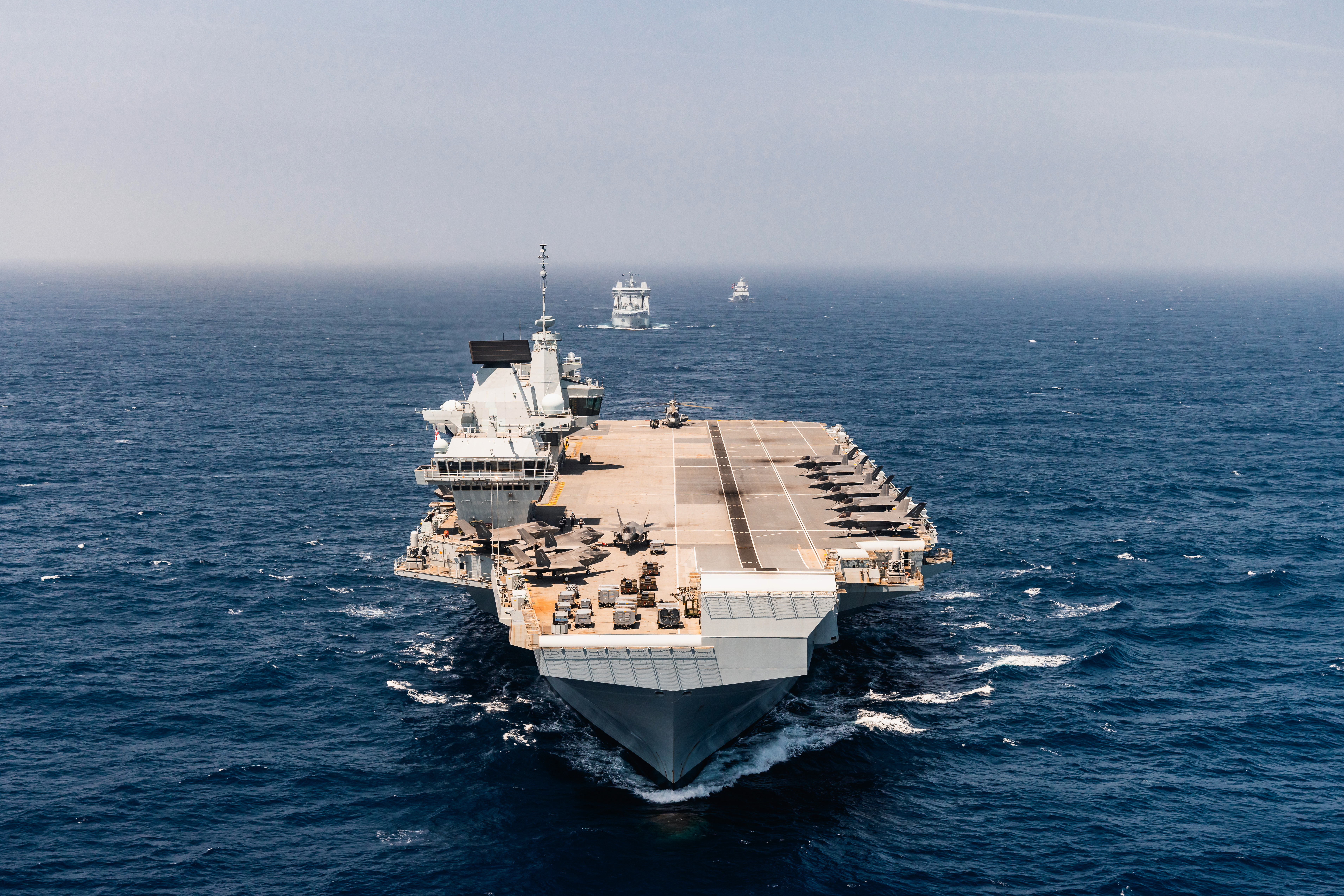
Ultimately, however, the Royal Navy might look to a loyal-wingman-type drone, of the kind that the U.S. Navy is working on under its Collaborative Combat Aircraft (CCA) program. These uncrewed aircraft will be highly autonomous but still designed primarily to work closely together with crewed platforms, at least initially. In the past, the U.S. Navy has said it wants to have uncrewed platforms make up the majority of its future carrier air wings, with up to 60 percent of all aircraft on each flattop being pilotless in the coming decade or two.
The kinds of ambitions the U.S. Navy has for its CCAs would certainly seem to tally with the aspiration to field “autonomous collaborative platforms” aboard the U.K. carriers.
Last year, General Atomics presented a vision for how a new uncrewed aircraft, a carrier-capable member of its Gambit drone family, could fit into a future air wing aboard the Queen Elizabeth class carriers. A rendering, shown below, featured a catapult-equipped HMS Prince of Wales with a Gambit-series drone ready to launch. The rendering also depicts an air wing that includes carrier-capable MQ-9B drones fitted with a STOL kit, a separate concept that General Atomics unveiled in 2022, as well as F-35Bs.
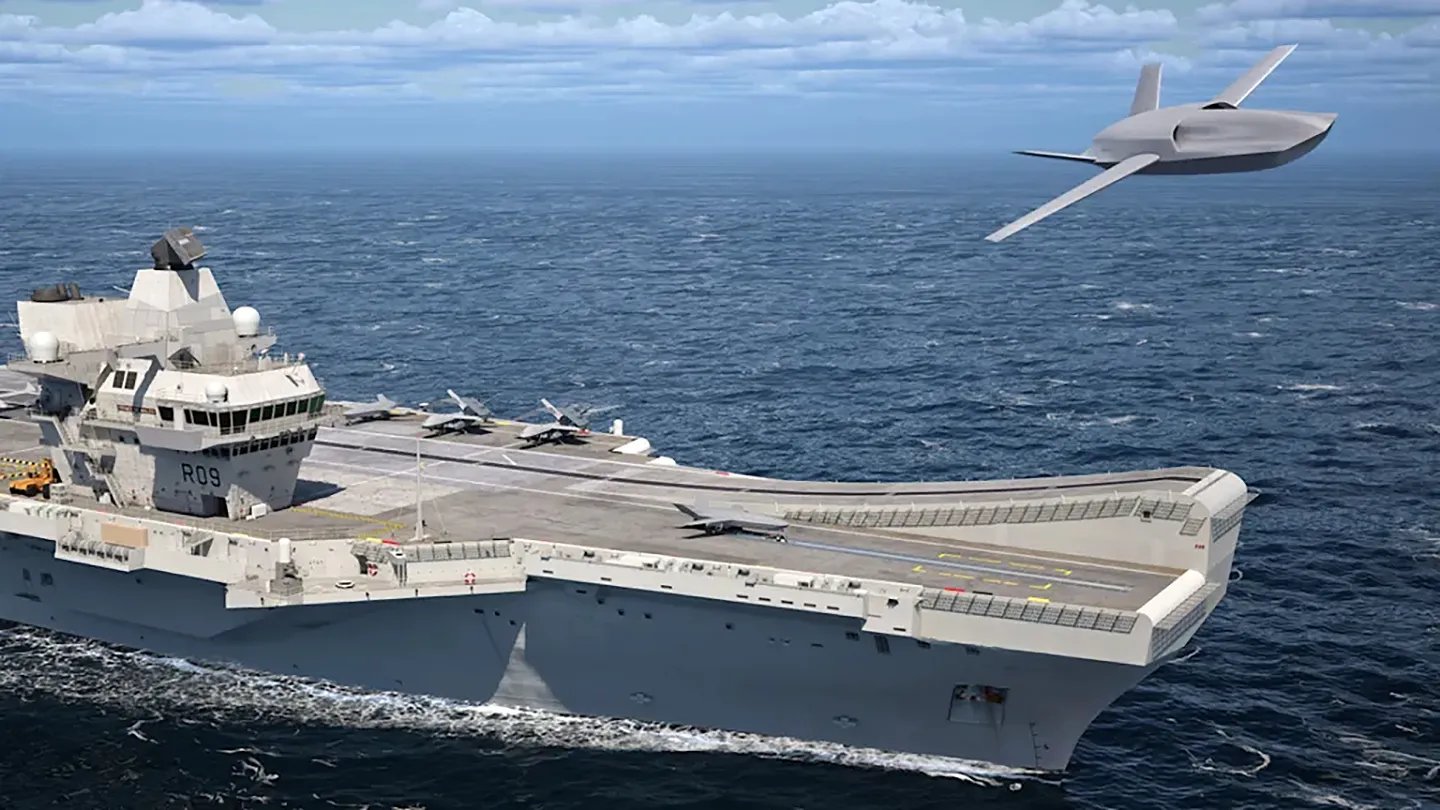
“We first started thinking of this as a carrier-capable version of Gambit 2, our air-to-air UCAV [uncrewed combat air vehicle] variant, so that’s what is reflected on the Farnborough booth graphics,” C. Mark Brinkley, a General Atomics spokesman, told TWZ at the time. “Lately, we’ve been thinking of it as a new concept we’re calling Gambit 5, designed for carrier launch and recovery, but weapons delivery need not be a primary requirement. It could be ISR [intelligence, surveillance, and reconnaissance] focused, like Gambit 1, or even some hybrid.”
Other options for the Royal Navy might include a version of the U.S. Navy’s MQ-25 Stingray, which is initially being developed for aerial refueling, but which could potentially be adapted for other missions, including surveillance and electronic warfare, and even strike.
As well as the MQ-25, the MQ-28 Ghost Bat, a loyal-wingman-type drone designed by Boeing’s Australian subsidiary, seems to have attracted some official interest in the United Kingdom. In February, Rear Adm. James Parkin, Director Develop for the Royal Navy, gave a presentation that included a slide with a Boeing rendering showing a variant or derivative of the MQ-28 with a visible tailhook landing on a Queen Elizabeth class carrier.
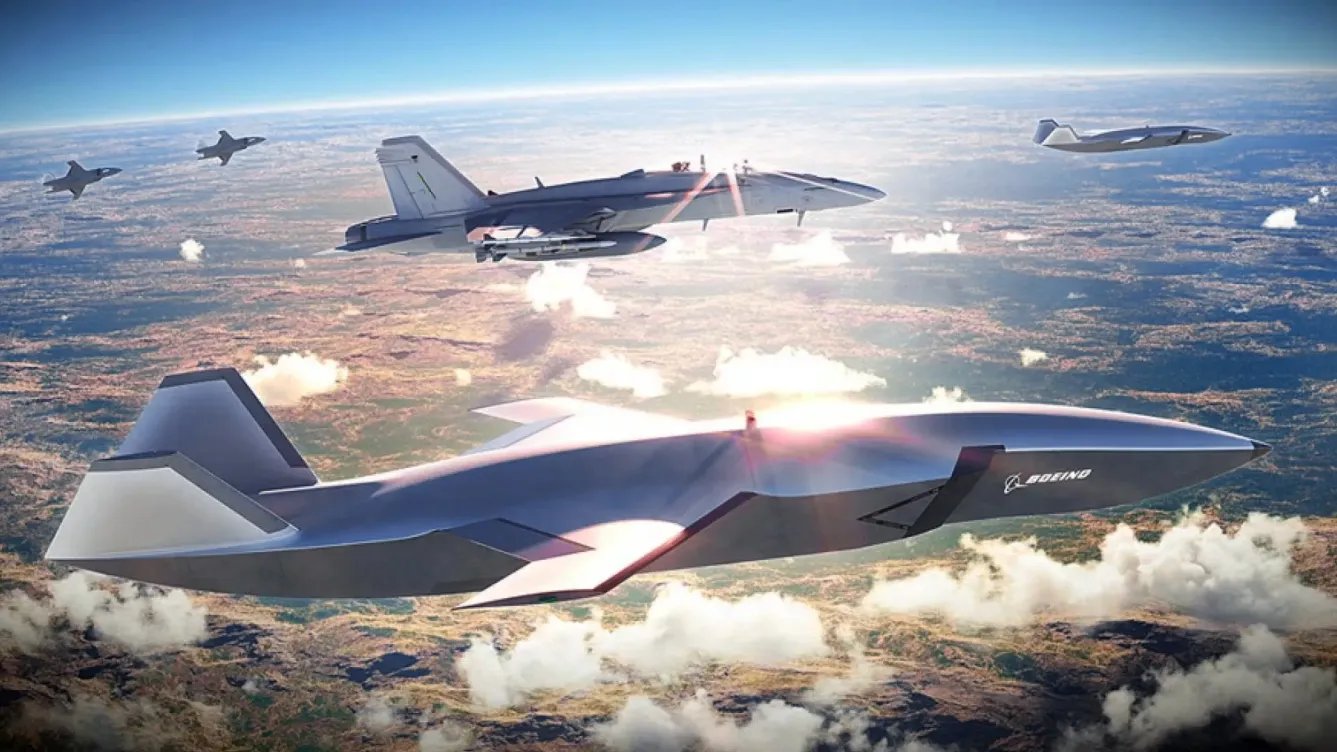
Outside of larger drones (and potentially even CTOL crewed aircraft), the review also sees a place for “single-use drones” aboard the carriers.
Already, the Royal Navy has conducted trials involving smaller, jet-powered drones, with the QinetiQ Banshee Jet 80+, best known as a target drone, being launched from HMS Prince of Wales in 2021. An adaptation of this, or a similar drone, could fulfill this role.
The Banshee can be launched using a portable catapult from the deck of the carrier, and — provided it’s not expended — it can be recovered via parachute and land in the water after completing its mission.
The Royal Navy’s experiments with smaller carrier-based drones are being carried out under Project Vampire, which specifies the use study of “lightweight, fixed-wing carrier-borne crewless autonomous systems,” for which the twin-jet-engine-powered Banshee provides a useful surrogate. Operational drones in this class could provide the carrier air wing with important new vectors for carrying out missions, including strike, electronic warfare, and surveillance. Notably, after its appearance on the Prince of Wales, an operationalized version of the Banshee appeared in combat in Ukraine, as you can read about here.
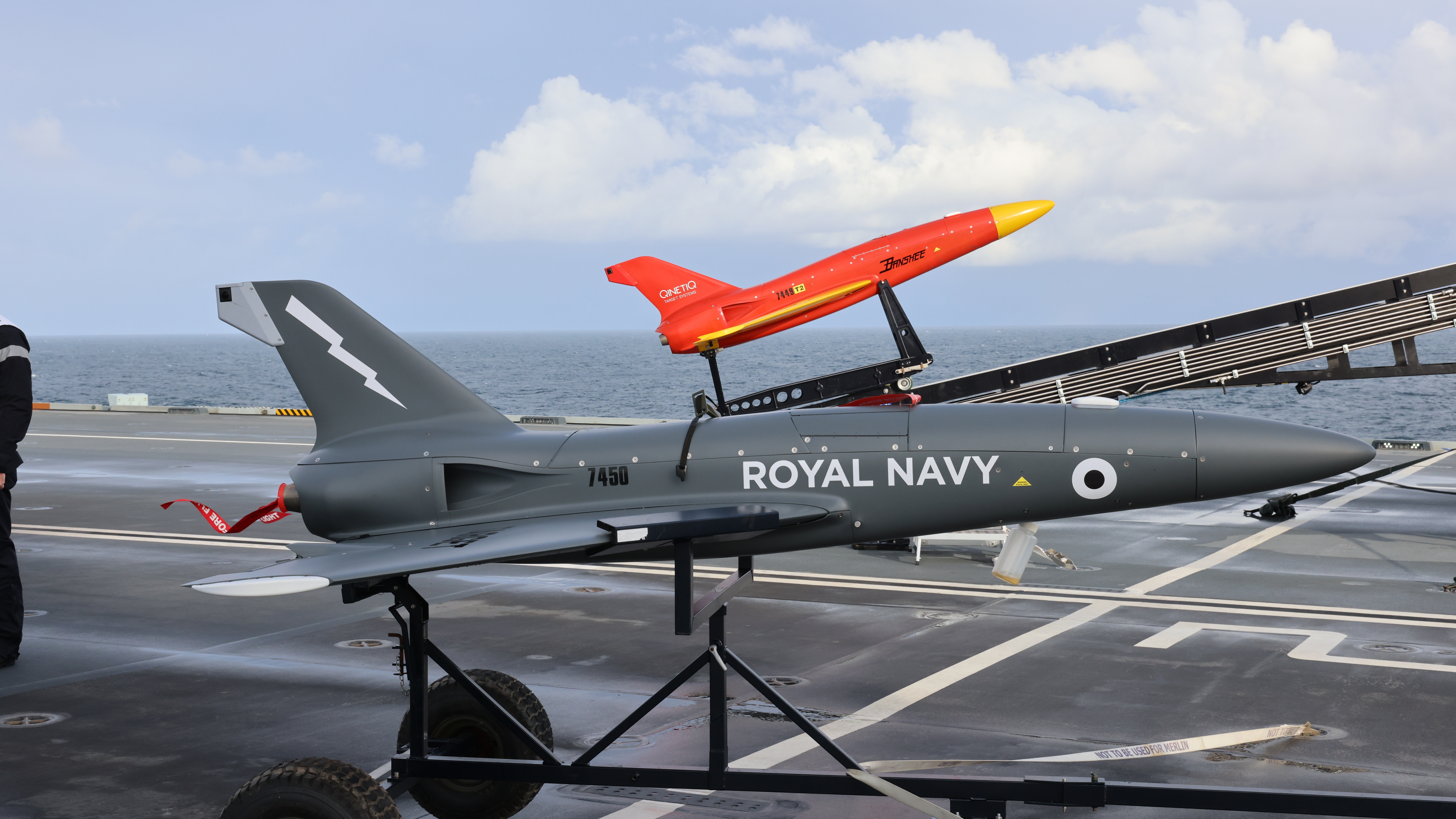
Most intriguingly, the hybrid air wing should, “eventually,” also feature “long-range missiles capable of being fired from the carrier deck,” the report recommends.
The explicit mention of a missile (rather than a drone) suggests that the Royal Navy is looking at the option of launching a cruise missile from the carrier, perhaps even a hypersonic weapon. A ballistic missile is also a possibility, albeit less likely.
Currently, only the Russian Navy operates a carrier with provision to launch its own cruise missiles, something you can read about in depth here. However, in recent years, there have been questions about whether the P-700 missile tubes on the Admiral Kuznetsov were still active, let alone whether they were filled with live rounds of the anti-ship missiles. This is more or less academic now, anyway, with the Admiral Kuznetsov out of operational service since mid-2022 and little sign that this will change anytime soon.

While the Admiral Kuznetsov was outfitted with cruise missiles to maximize the offensive weapons that could be directed against U.S. Navy Carrier Battle Groups and high-value convoys, the Royal Navy would likely be looking to add an additional land-attack capability to its carriers. On the other hand, a dual-use missile could also be a possibility, especially with a resurgence of interest in anti-surface warfare.
Long-range cruise missiles would also not have to be stowed in below-deck launchers, as in the Admiral Kuznetsov, which would require significant changes to the internal layout of the boat, but could instead be fired from the flight deck using a truck, trailer, or container-based launcher.
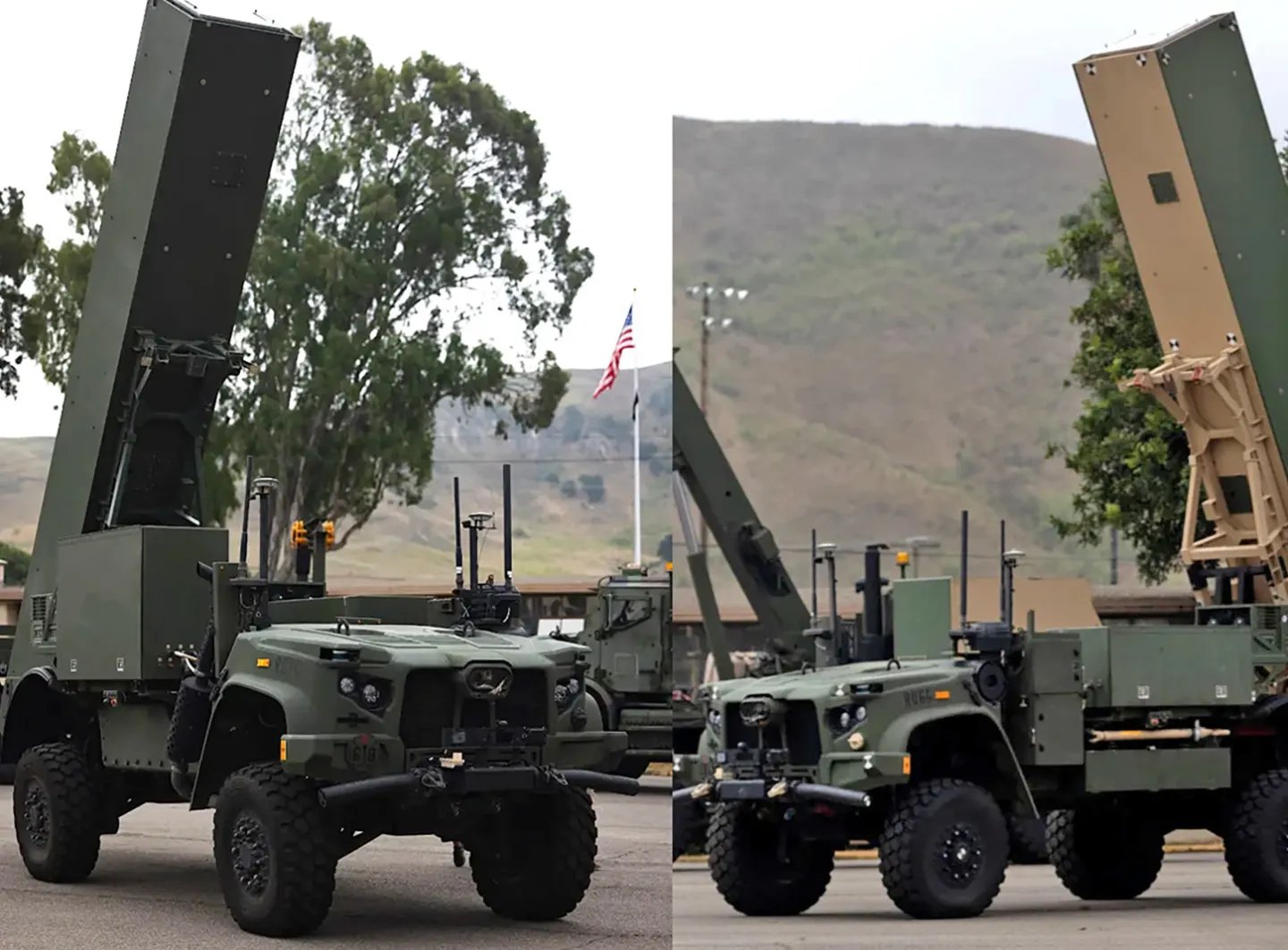
Currently, the Royal Navy uses conventionally armed Tomahawk cruise missiles to arm its Astute class nuclear-powered attack submarines. However, it also plans to provide a Tomahawk capability on its forthcoming Type 26 and Type 31 frigates, via the Mk 41 Vertical Launch System (VLS). The current Type 45 destroyer also has the potential to be retrofitted with a Tomahawk capability. The Tomahawk has a range of around 1,000 miles with a 1,000-pound unitary warhead.
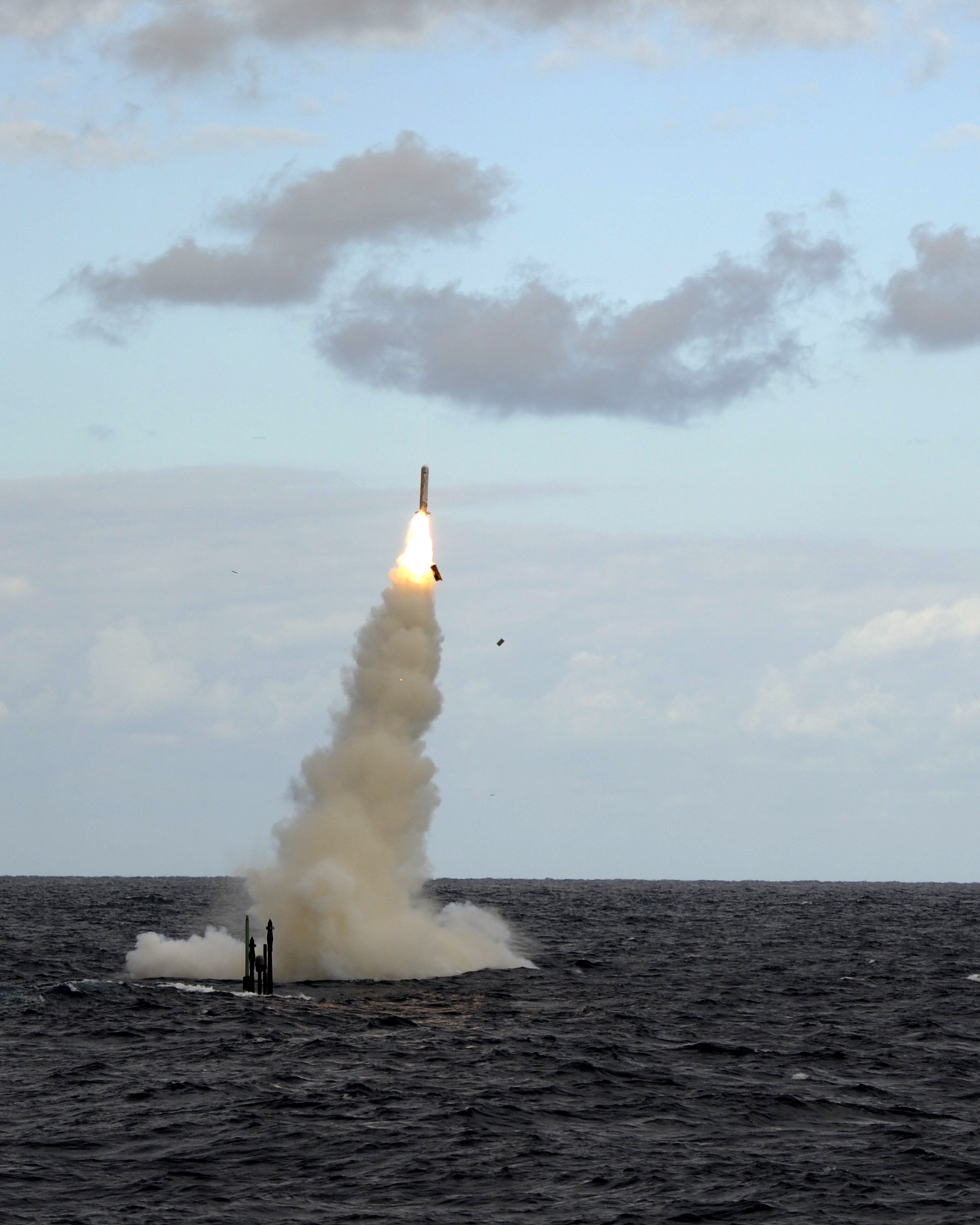
Meanwhile, the United Kingdom is increasingly looking at new long-range strike weapons, notably a “deep precision strike” weapon with a range of over 2,000 kilometers (1,243 miles) that it is pursuing with Germany. While details of the missile are yet to be finalized, it could well be developed with the option to be fired from carrier decks as well as ground launchers.
Whatever happens, there’s no doubt that these plans for the so-called hybrid air wings are full of technological challenges. Not only will it be complex to introduce these new capabilities on vessels that were not originally designed for them, but it will be a very costly endeavor. Coming at a time when there are many competing high-profile U.K. defense programs, it remains unclear how realistic these aspirations are from a fiscal perspective.
Contact the author: thomas@thewarzone.com
